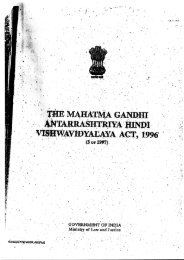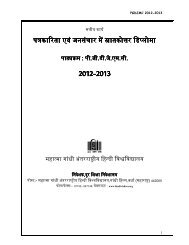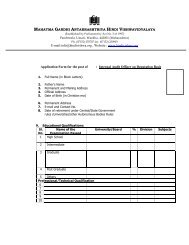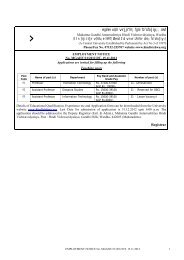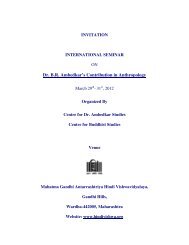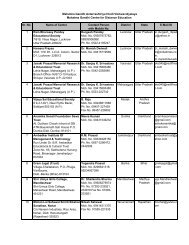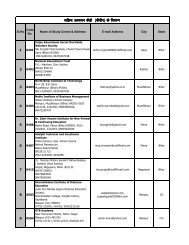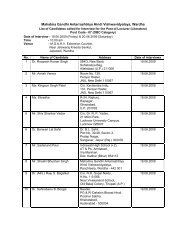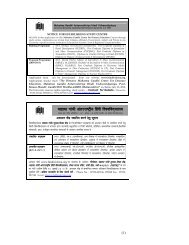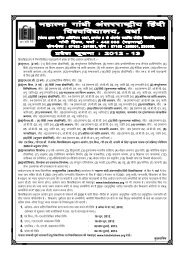Mamta Kalia
Mamta Kalia
Mamta Kalia
Create successful ePaper yourself
Turn your PDF publications into a flip-book with our unique Google optimized e-Paper software.
place where uplas or cow dung cakes<br />
were made. There would be five to six<br />
baskets of dung to be taken out from<br />
every cowshed. During the winter months<br />
it was a very painful job. The cows,<br />
buffaloes and bullocks would be tethered<br />
in long hallways. The floor would be<br />
covered with the dry leaves of cane<br />
or straw. The dung and the urine of<br />
the animals would spread all over the<br />
floor overnight. The matting would be<br />
changed after ten or fifteen days. Or<br />
sometimes a layer of dry leaves would<br />
be added on top of the soiled one. To<br />
search for dung in the stinking cowsheds<br />
was extremely unpleasant. The stink<br />
made one feel faint.<br />
To compensate us for all this work,<br />
we got five seers of grain per two animals;<br />
that is, about two and a half kilos of<br />
grain. Each Taga household with ten<br />
animals gave twenty-five seers of grain<br />
a year-about twelve to fifteen kilos, a<br />
leftover roti at noon every day, specially<br />
made by mixing the flour with husk since<br />
it was for the Chuhras. Sometimes the<br />
joothan, the scraps, would also be put<br />
in the basket with the rotis for us.<br />
During a wedding, when the guests<br />
and the baratis, the bridegroom’s party,<br />
were eating their meals, the Chuhras<br />
would sit outside with huge baskets. After<br />
the baratis had eaten, the dirty pattals<br />
or leaf-plates were put in the Chuhras’<br />
baskets, which they took home, to save<br />
the joothan sticking to them. The little<br />
pieces of pooris, bits of sweetmeats, and<br />
a little bit of vegetable were enough<br />
to make them happy. The joothan was<br />
eaten with a lot of relish. The bridegroom’s<br />
guests who didn’t leave enough scraps<br />
on their pattals were denounced as<br />
gluttons. Poor things, they had never<br />
enjoyed a wedding feast. So they had<br />
licked it all up. During the marriage<br />
season, our elders narrated, in thrilled<br />
voices, stories of the baratis that had<br />
left several months of joothan.<br />
The pieces of pooris that were<br />
collected from the pattals were dried<br />
in the sun. A cloth would be spread<br />
on a charpai to dry them. Often I would<br />
be placed on guard duty because the<br />
drying pooris attracted crows, hens and<br />
dogs. Even a moment’s lapse and the<br />
pooris would vanish. Hence, one would<br />
have to sit near the cot with a stick<br />
in hand.<br />
These dried up pooris were very useful<br />
during the hard days of the rainy season.<br />
They would be soaked in water and then<br />
boiled. The boiled pooris were delicious<br />
with finely ground red chilli pepper and<br />
salt. Sometimes they were mixed with<br />
gur or molasses, to make a gruel and<br />
this dish was eaten with great delight.<br />
When I think about all those things<br />
today, thorns begin to prick my heart.<br />
What sort of a life was that? After working<br />
hard day and night, the price of our<br />
sweat was just joothan. And yet no one<br />
had any grudges. Or shame. Or<br />
repentance.<br />
When I was a young boy, I used<br />
to go with my parents to help them<br />
out. Looking at the food of the Tagas,<br />
I would wonder why we never got to<br />
eat food like that. When I think of those<br />
days today, I feel nauseated.<br />
This past year, Sukhdev Singh Tyagi’s<br />
April-June 2010 :: 13




